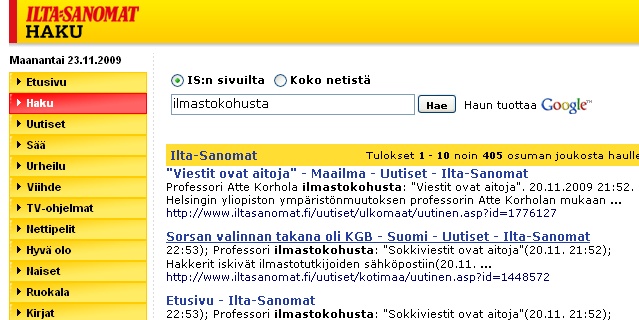Kliima soojenemine võib osutuda teadlaste vandenõuks
Kindlasti on kõik kuulnud kliima soojenemisest ja CO2 gaaside vähendamise Kyoto kokkuleppest. Järgmisel kuul tuleb Kopenhaagenis vastav kliima alane tippkohtumine. Alles hiljuti häkiti aga ports kliimateadlaste e-maile ja faile ning nendest jääb mulje hoopis kliima muutuse kokku leppimisest ja mitte faktide tõlgendamise järel tekkinud konsensusest. Neis kirjades arutati, milliseid andmeid avaldada, milliseid mitte ja kuidas skeptikutele vastata või neid naeruvääristada.
Asjast kirjutas ka soomlaste Ilta-Sanomat välisuudiste rubriigis aga juba samal õhtul oli sellelt aadressilt artikkel kadunud. Huvitaval kombel on selle kokkuvõte säilinud isegi Ilta Sanomate otsingus, kuid ainult selle 1 lauselise kokkuvõttena:

ja see sama tekstina
Helsingin yliopiston ympäristönmuutoksen professorin Atte Korholan mukaan sokkiuutiset ilmastotutkijoiden väitetystä koordinoidusta vääristelystä perustuvat aitoihin sähköposteihin.
http://www.iltasanomat.fi/uutiset/ulkomaat/uutinen.asp?id=1776127
Ning tõlge
Helsingi ülikooli keskkonna muutuste professori Atte Korhola kinnitusel šokiuudis keskkonnateadlaste väidetavast koordineeritud moonutamisest rajaneb ehtsatel e-mailidel.
Sellest kadunud artiklist leiab märkme ka Ilta-Sanomate kodulehelt aga isegi veelgi lühemana:

Kogu kliima teadlaste must südametunnistus on aga lühidalt kirjeldatud 20. oktoobri New York Times´i artiklis: Hacked E-Mail Is New Fodder for Climate Dispute.
Hundreds of private e-mail messages and documents hacked from a computer server at a British university are causing a stir among global warming skeptics, who say they show that climate scientists conspired to overstate the case for a human influence on climate change.
The e-mail messages, attributed to prominent American and British climate researchers, include discussions of scientific data and whether it should be released, exchanges about how best to combat the arguments of skeptics, and casual comments — in some cases derisive — about specific people known for their skeptical views.
In one e-mail exchange, a scientist writes of using a statistical “trick” in a chart illustrating a recent sharp warming trend. In another, a scientist refers to climate skeptics as “idiots.”
Some skeptics asserted Friday that the correspondence revealed an effort to withhold scientific information. “This is not a smoking gun; this is a mushroom cloud,” said Patrick J. Michaels, a climatologist who has long faulted evidence pointing to human-driven warming and is criticized in the documents.
The evidence pointing to a growing human contribution to global warming is so widely accepted that the hacked material is unlikely to erode the overall argument. However, the documents will undoubtedly raise questions about the quality of research on some specific questions and the actions of some scientists.
The revelations are bound to inflame the public debate as hundreds of negotiators prepare to negotiate an international climate accord at meetings in Copenhagen next month, and at least one scientist speculated that the timing was not coincidental.
In a 1999 e-mail exchange about charts showing climate patterns over the last two millenniums, Phil Jones, a longtime climate researcher at the East Anglia Climate Research Unit, said he had used a “trick” employed by another scientist, Michael Mann, to “hide the decline” in temperatures.
Dr. Mann, a professor at Pennsylvania State University, confirmed in an interview that the e-mail message was real. He said the choice of words by his colleague was poor but noted that scientists often used the word “trick” to refer to a good way to solve a problem, “and not something secret.”
At issue were sets of data, both employed in two studies. One data set showed long-term temperature effects on tree rings; the other, thermometer readings for the past 100 years.
Through the last century, tree rings and thermometers show a consistent rise in temperature until 1960, when some tree rings, for unknown reasons, no longer show that rise, while the thermometers continue to do so until the present.
Dr. Mann explained that the reliability of the tree-ring data was called into question, so they were no longer used to track temperature fluctuations. But he said dropping the use of the tree rings was never something that was hidden, and had been in the scientific literature for more than a decade. “It sounds incriminating, but when you look at what you’re talking about, there’s nothing there,” Dr. Mann said.
In addition, other independent but indirect measurements of temperature fluctuations in the studies broadly agreed with the thermometer data showing rising temperatures.
Samuti oli kliima soojenemise teooria suhtes üks Siberi igikeltsa uurijatest.
Mark Šatz esindab neid teadlasi, kes suhtuvad skeptiliselt juttudesse praeguse kliimamuutuse hukutavast mõjust.
„Kasvuhoonegaasid on kliima soojenemise tagajärg, mitte põhjus,” lausub ta peaaegu kurjalt. „Üks miljon aastat tagasi, kui toimus suur kliima soojenemine – kas siis olid selles dinosaurused süüdi? Inimesi siis ju veel maa peal polnud.”
Šatz on veendunud, et praeguste kliimamuutuste põhjustes on inimese roll viis protsenti, ülejäänu on looduslikud protsessid. Kasvuhoonegaaside õhku paiskamist piirava Kyoto kliimaprotokolli kohta ütleb ta aga nii: „See on vaeste riikide viis avaldada survet rikastele riikidele.”